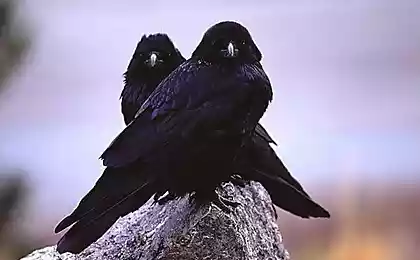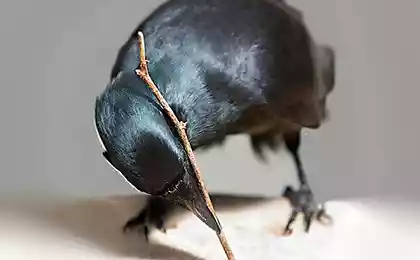436
The ravens do know how to count, found neuroscientists
Monitoring brain Raven helped neurophysiologists to find the area of the brain that is responsible for counting objects and simple arithmetic, and thus to prove that these birds "Einsteins" really know how to count at the level of a kindergartner, said in an article published in the journal Proceedings of the National Academy of Sciences.
Long enough the most intelligent members of the animal world was considered to be chimpanzees and apes, but in recent years their position started to push some birds – new Caledonian crowsthat can make tools, solve puzzles on the uptake for 5-year-olds. Not far behind them are the usual crows and jays.

Helen Dietz (Helen Ditz) and her colleague Andreas Nieder (Nieder Andreas) from the University of tübingen (Germany) tried to understand if crows can count and whether they possess an abstract concept of number, or we all think so, watching a few birds that were playing a computer game on the screen of the tablet.
Interestingly, the first hints of the ability of birds to account in the mind of scientists discovered not among the "smart" members of the genus Corvidae, but among ordinary pigeons that are traditionally considered rather stupid birds. As found by Damian Scarfe back in 2011, the pigeons were able to differentiate the numbers from one to nine, and to choose the group of figures on the screen where there were more.
As expected, this conclusion caused a lot of criticism from many neuroscientists, and they said that such statements need reinforcements in the data obtained in the monitoring operation of the brain.
It is possible that the pigeons were guided by some invisible scientist characteristics that issue, where you had to click a beak for a portion of food.
Dietz and the Netherlands decided to test this idea on the crows, using the analogue computer games, played doves of the experiment of their colleagues. Before each round the computer screen was cleared, and then it displayed a few points that Raven had to calculate and then "draw" their beak, when the display is again cleared.
The size of dots and their location is constantly changing, to exclude the possibility that the bird just remember the whole picture, not counting the spots on the screen. During each session of game biologists monitored the brain Raven, noting all the divisions of her nervous system that were activated while viewing pictures and the introduction of answer.
As the scientists expected, the birds did pretty well with these puzzles, tapping the correct answer to 73% of cases, which suggests that they did not act at random (then the success rate would be equal to 50%). Monitor the work of their bark showed that for each number, regardless of the shape and location of the circles on the screen, answered its own group of nerve cells.
This means that the crows represent numbers in the form of some abstract shapes or structures whose existence does not depend on how to look and what are considered to be objects in the real world.
Thus, Dietz and the Netherlands managed to prove that birds do know how to count, and that their "cage account" at work in almost the same way as humans and mammals.

This discovery is potential evidence in favor of the fact that numeracy is a very ancient art, which could potentially leave at the time of separation of the ancestors of birds and mammals that occurred about 300 million years ago. On the other hand, as acknowledged by scientists, it is likely that the feathered and furry inhabitants of the Earth have mastered the basics of arithmetic separately from each other in the so call convergent evolution. published
P. S. And remember, only by changing their consumption — together we change the world! ©
Source: www.nanonewsnet.ru/news/2015/vorony-deistvitelno-umeyut-schitat-vyyasnili-neirofiziologi
Long enough the most intelligent members of the animal world was considered to be chimpanzees and apes, but in recent years their position started to push some birds – new Caledonian crowsthat can make tools, solve puzzles on the uptake for 5-year-olds. Not far behind them are the usual crows and jays.

Helen Dietz (Helen Ditz) and her colleague Andreas Nieder (Nieder Andreas) from the University of tübingen (Germany) tried to understand if crows can count and whether they possess an abstract concept of number, or we all think so, watching a few birds that were playing a computer game on the screen of the tablet.
Interestingly, the first hints of the ability of birds to account in the mind of scientists discovered not among the "smart" members of the genus Corvidae, but among ordinary pigeons that are traditionally considered rather stupid birds. As found by Damian Scarfe back in 2011, the pigeons were able to differentiate the numbers from one to nine, and to choose the group of figures on the screen where there were more.
As expected, this conclusion caused a lot of criticism from many neuroscientists, and they said that such statements need reinforcements in the data obtained in the monitoring operation of the brain.
It is possible that the pigeons were guided by some invisible scientist characteristics that issue, where you had to click a beak for a portion of food.
Dietz and the Netherlands decided to test this idea on the crows, using the analogue computer games, played doves of the experiment of their colleagues. Before each round the computer screen was cleared, and then it displayed a few points that Raven had to calculate and then "draw" their beak, when the display is again cleared.
The size of dots and their location is constantly changing, to exclude the possibility that the bird just remember the whole picture, not counting the spots on the screen. During each session of game biologists monitored the brain Raven, noting all the divisions of her nervous system that were activated while viewing pictures and the introduction of answer.
As the scientists expected, the birds did pretty well with these puzzles, tapping the correct answer to 73% of cases, which suggests that they did not act at random (then the success rate would be equal to 50%). Monitor the work of their bark showed that for each number, regardless of the shape and location of the circles on the screen, answered its own group of nerve cells.
This means that the crows represent numbers in the form of some abstract shapes or structures whose existence does not depend on how to look and what are considered to be objects in the real world.
Thus, Dietz and the Netherlands managed to prove that birds do know how to count, and that their "cage account" at work in almost the same way as humans and mammals.

This discovery is potential evidence in favor of the fact that numeracy is a very ancient art, which could potentially leave at the time of separation of the ancestors of birds and mammals that occurred about 300 million years ago. On the other hand, as acknowledged by scientists, it is likely that the feathered and furry inhabitants of the Earth have mastered the basics of arithmetic separately from each other in the so call convergent evolution. published
P. S. And remember, only by changing their consumption — together we change the world! ©
Source: www.nanonewsnet.ru/news/2015/vorony-deistvitelno-umeyut-schitat-vyyasnili-neirofiziologi























